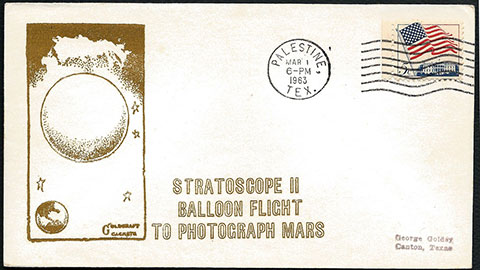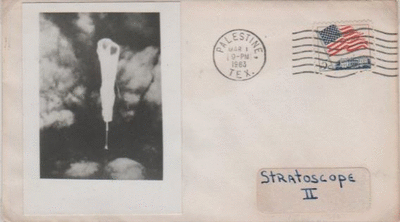Space Cover #389: Stratoscope II Balloon from Palestine, Texas and the first successful flight from thereThis, the first successful flight of a Stratoscope II balloon, was also the first successful flight launched from the National Center for Atmospheric Research (NCAR) in Palestine (pronounced - Palace Teen'), Texas on March 1, 1963. In late 1963 the station was named, the National Scientific Balloon Flight Station (NSBF). The purpose of this particular flight was to "trace the infrared spectrum of Mars from a level in the Earth's atmosphere of 80,000 feet where the absorption due to the remaining carbon dioxide and water vapor would not be restrictive."
A prior test flight of this first successful balloon launch by the NCAR had been launched on Dec. 12, 1962, but due to a separation system failure it was shot down by U.S. Navy fighters off the Florida coast. This huge telescope landed near Pulaski, Tennessee after an 11.5 hour flight. Shown here is a Goldey cover for this event.
A series of technical difficulties occurred during the flight which severely restricted the number and quality of the spectrometer scans that were obtained. They found 1) it improbable that the water vapor content on Mars was greater than 40u. and 2) the total pressure at the surface of Mars was assumed to be 87 mbar (millibars) and that the amount of CO2 in the atmosphere of Mars amounted to be about 6000 cm.atm (centimeters of atmosphere) rather than the 3000 cm.atm that was previously estimated.
The analyses of these data were expected to yield the water vapor abundance, and improved information of the carbon dioxide abundance, and possibly some evidence of organic matter on the surface of Mars. Only some of these results were obtained because of a variety of instrumental difficulties.
While most balloon launch covers from Palestine, Texas are of low value, a cover for this Mars probe mission was sold once for $30. The NCAR was controlled by the University Corporation for Atmospheric Research in Boulder, Colorado, under contract funding and sponsorship by the National Science Foundation of the U.S. government located in Washington, DC, not by NASA at that time.
In 1973 the station was renamed, the National Scientific Balloon Facility (NSBF). Later, after the Columbia Space Shuttle disintegrated over and around the area, the name was changed again to the Columbia Scientific Balloon Facility.
Today the base has all the infrastructure necessary to operate balloons of any size with areas for the integration of scientific gondolas, buildings of storage, hangars, a complete weather station with three meteorologists full-time, and two Cessna aircraft for pursuit and air support. Recently the technology of the control center has been improved, allowing analyzing in real time the scientific and flight information from the balloons in flight, not mattering from where they have been launched.
Although in the first years, flights were made during the winter months, these have been prohibited by NASA due to the risk that balloons move towards populated areas in the Gulf of Mexico or slip into air traffic corridors. Instead in these months campaigns are conducted from Fort Sumner in New Mexico.
See the article in the Astrophile, Journal of the Space Unit, for additional information about the Texas facility.













